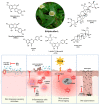Unlocking Therapeutic Potential: Comprehensive Extraction, Profiling, and Pharmacological Evaluation of Bioactive Compounds from Eclipta alba (L.) Hassk. for Dermatological Applications
- PMID: 38202343
- PMCID: PMC10781016
- DOI: 10.3390/plants13010033
Unlocking Therapeutic Potential: Comprehensive Extraction, Profiling, and Pharmacological Evaluation of Bioactive Compounds from Eclipta alba (L.) Hassk. for Dermatological Applications
Abstract
Herbal medicine has been studied as an alternate approach to modern medicine as it is more cost-effective and accessible via natural sources. Eclipta alba (E. alba, L.) Hassk. is a weed plant abundantly distributed throughout different regions of the world and contains abundant bioactive compounds used for various skin conditions. In this review, we aimed to gather information from the literature about the extraction, separation, and identification of these bioactive compounds and their potential in skin diseases. Relevant studies published before August 2023 were identified and selected from electronic databases, including Scopus, SciFinder, ScienceDirect, Google Scholar, and Wiley Library, using the following keywords: Eclipta alba, Eclipta prostrata, phytochemicals, extraction, separation, isolation, identification, characterization, pharmacological activity, and skin conditions. Up-to-date extraction, separation, and identification methods of bioactive compounds from E. alba and their skin-related pharmacological activities are discussed in this review. As there are limitations regarding extraction, separation, and identification methods, and in-depth mechanistic and human studies of the skin-related pharmacological activities of bioactive compounds, these gaps are areas for future research to expand our understanding and broaden the potential applications of this medicinal weed plant, including the development of cosmeceutical and skincare products, anti-inflammatory agents, and formulations for dermatological treatments.
Keywords: Eclipta alba; Eclipta prostrata; extraction; identification; phytochemicals; separation.
Conflict of interest statement
The authors declared no conflicts of interest.
Figures



Similar articles
-
Eclipta prostrata (L.) L. (Asteraceae): Ethnomedicinal Uses, Chemical Constituents, and Biological Activities.Biomolecules. 2021 Nov 22;11(11):1738. doi: 10.3390/biom11111738. Biomolecules. 2021. PMID: 34827736 Free PMC article. Review.
-
Phytochemistry and neuroprotective effects of Eclipta alba (L.) Hassk.J Complement Integr Med. 2019 May 21;17(1):/j/jcim.2019.17.issue-1/jcim-2019-0026/jcim-2019-0026.xml. doi: 10.1515/jcim-2019-0026. J Complement Integr Med. 2019. PMID: 31116703 Review.
-
A review on traditional uses, phytochemistry and pharmacology of Eclipta prostrata (L.) L.J Ethnopharmacol. 2019 Dec 5;245:112109. doi: 10.1016/j.jep.2019.112109. Epub 2019 Aug 5. J Ethnopharmacol. 2019. PMID: 31395303 Review.
-
Optimization of sample preparation variables for wedelolactone from Eclipta alba using Box-Behnken experimental design followed by HPLC identification.Ann Pharm Fr. 2013 Jul;71(4):249-59. doi: 10.1016/j.pharma.2013.04.002. Epub 2013 May 30. Ann Pharm Fr. 2013. PMID: 23835023
-
Protective effect of the methanolic leaf extract of Eclipta alba (L.) Hassk. (Asteraceae) against gentamicin-induced nephrotoxicity in Sprague Dawley rats.J Ethnopharmacol. 2016 May 26;184:18-21. doi: 10.1016/j.jep.2016.03.002. Epub 2016 Mar 3. J Ethnopharmacol. 2016. PMID: 26945981
Cited by
-
Carvacrol and Streptomycin in Combination Weaken Streptomycin Resistance in Pectobacterium carotovorum subsp. carotovorum.Plants (Basel). 2025 Mar 14;14(6):908. doi: 10.3390/plants14060908. Plants (Basel). 2025. PMID: 40265826 Free PMC article.
-
Anti-Inflammatory Potential and Synergic Activities of Eclipta prostrata (L.) L. Leaf-Derived Ointment Formulation in Combination with the Non-Steroidal Anti-Inflammatory Drug Diclofenac in Suppressing Atopic Dermatitis (AD).Life (Basel). 2024 Dec 30;15(1):35. doi: 10.3390/life15010035. Life (Basel). 2024. PMID: 39859974 Free PMC article.
-
Study design of herbal medicine clinical trials: a descriptive analysis of published studies investigating the effects of herbal medicinal products on human participants.BMC Complement Med Ther. 2024 Nov 8;24(1):391. doi: 10.1186/s12906-024-04697-7. BMC Complement Med Ther. 2024. PMID: 39516879 Free PMC article. Review.
-
Antioxidant Effects of E. alba: A Narrative Review.J Pharm Bioallied Sci. 2024 Dec;16(Suppl 4):S4060-S4063. doi: 10.4103/jpbs.jpbs_1389_24. Epub 2024 Dec 12. J Pharm Bioallied Sci. 2024. PMID: 39926801 Free PMC article.
References
-
- Lahlou M. The success of natural products in drug discovery. Pharmacol. Pharm. 2013;4:17–31. doi: 10.4236/pp.2013.43A003. - DOI
-
- Swe K.N.N., Soe S.W.M.L. Screening of Phytochemical Constituents and Some Pharmacological Activities of Eclipta alba Hassk. Plant (Trailing eclipta) 2nd Myanmar Korea Conf. Res. J. 2019;2:57–63.
-
- Bhalerao S.A., Verma D.R., Teli N.C., Murukate V.R. Eclipta alba (L): An overview. Int. J. Bioassays. 2013;2:1443–1447.
Publication types
Grants and funding
LinkOut - more resources
Full Text Sources
Research Materials
Miscellaneous

